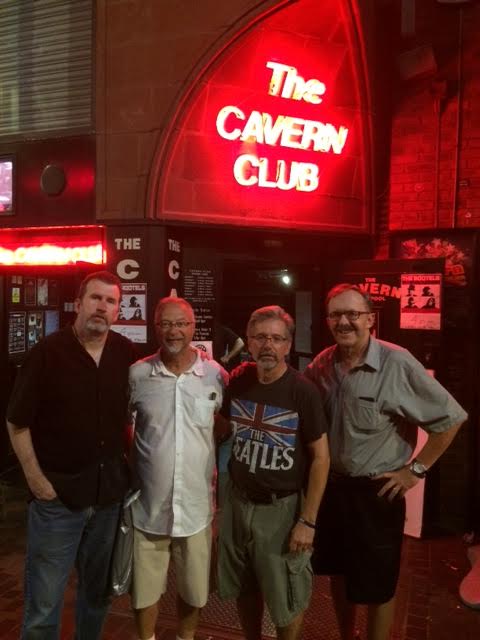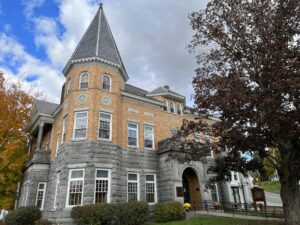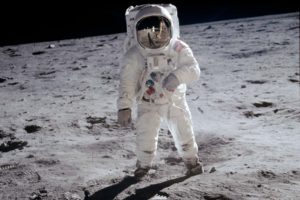As Joe and I walk into the vestibule of a rather ordinary house, Phil follows quickly and closes the house door behind us. The front door is already shut, so we’re temporarily sealed in a confined space. Phil starts to lead us in an a cappella version of the early Beatles song, “I Saw Her Standing There.”
“Well, she was just 17
You know what I mean
And the way she looked was way beyond compare
So how could I dance with another (Ooh)
When I saw her standing there…”
We trail off around the words “my heart went boom,” and look at each other. “Not bad,” Phil says, for a trio of graying Beatles fans with rough voices. The sound had ricocheted around the wood and glass enclosure nicely. We were pleased with the acoustics.
In reality our crooning came nowhere near the beautiful harmonies Paul McCartney, John Lennon, George Harrison, and Ringo Starr produced while recording or performing the collection of original songs that forever changed rock and roll. But we’re thrilled on that late August, 2016, day, for we fully realize the goose-bumpy significance of where we just sang the tune.
We weren’t in just any vestibule. We had traveled some 3,100 miles from Boston and were standing in the front entryway of the Liverpool, England, house where Lennon grew up with his Aunt Mimi and her husband George. Also known as “Mendips,” 251 Menlove Ave., Liverpool was Lennon’s home for about 17 years — from the age of 5 until he left when the success of the Beatles accelerated. Like McCartney’s childhood home at 20 Forthlin Road a few miles away, the small two-story attached home is now owned by England’s National Trust. The house has been restored to its original condition and preserved meticulously for visits by generations to come.
As he got involved with Beatles pre-cursor group The Quarrymen, Lennon (and sometimes new friend McCartney) was often relegated to the vestibule when his rehearsals grew too loud for residents of the home. Thus, we sang where Lennon sang and strummed his guitar.

The vestibule in front of John Lennon’s childhood home in Liverpool, where we sang
***
Our unforgettable singing session in Lennon’s front porch was a brief but life-changing moment during an exhausting 10-day August tour of historical Beatles sites that started in London. We then moved on to their hometown of Liverpool on the Irish Sea, about 180 miles northwest of London. Our stops ranged from Abbey Road studios in London, where we tried to re-create the famous Abbey Road album cover of the Fab Four crossing the street, to the crowded, sweltering clubs in Liverpool where the Beatles earned their first fans
Joe Lahiff, Phil Santoro, and Ed Torres (L-R in the cover photo above) — longtime friends from the Boston area — invited me along on what they called a “once in a lifetime” trip to trace the Beatles’ history in England. My friends are true Beatles fans and know far more about the Fab Four than I, a more average Beatles follower. Joe, we estimate, has read almost every word written about the Beatles and pretty much owns their entire recorded catalog. Phil and Ed are close behind. Throughout the trip, they often added to explanations from guides.
While I was thrilled to learn more about this fabulous rock group, for me the trip had a slightly different goal. I have spent much of my lifetime learning everything I can about the creative process that artists, writers, musicians and others use to turn out works that literally live forever. Most often, though, the magic remains elusive. I usually settle for a first-hand look at the environment in which their creations took place. I also place a special emphasis on early work that led to more memorable efforts and achievements. Finally, I try find some way to personally connect to their world by immersing myself in the surroundings in which they began their work.
On a 2009 trip to Italy, for example, I examined some of Leonardo Da Vinci’s early work displayed in Florence’s fabulous Uffizi Gallery. Some of the Italian master’s early brush strokes helped reveal the path that would take him to Mona Lisa and The Last Supper. On a long 2014 road trip, I climbed to the second floor of a small building behind Ernest Hemingway’s 1930s Key West home. I stood transfixed, staring at the office and typewriter from which “Papa” produced early career gems such as “A Farewell to Arms,” “Death in the Afternoon,” and “For Whom the Bell Tolls.” And I’ve spent hours examining some of Bruce Springsteen’s early 1970s hand-written lyrics for his first two albums: “Greetings From Asbury Park, N.J.,” and “The Wild, The Innocent, and the E Street Shuffle.” Both were excellent records that drew little notice until “Born To Run” exploded onto the rock scene in 1975. The popularity of that album led many fans to go back to the first two albums in search of the artistry that fueled that historic third album.
***
I was thinking of those and other forays into studying the creative process when our group got to Liverpool in late August. It was here, in this gritty seaside port that fate conspired to first bring together McCartney and Lennon, and later Harrison and Starr.
The Liverpool of today is a mix of old and new. The seaport still thrives but is far more touristy than it likely was in the 1960s. The ferries on the River Mersey still operate, but mostly as an outing for visitors — the boats’ usefulness as commuter transport long having been replaced by two tunnels beneath the river. Downtown has witnessed significant changes, including a network of pedestrian-only pathways and malls surrounded by stores and restaurants that draw hordes of shoppers. The neighborhoods where the Beatles grew up, though (including much of the Penny Lane stretch), are largely unchanged. Some still bear scars from World War II bombing.

A typical Liverpool neighborhood, up the hill from downtown Liverpool
Aside from the great walking tours, visits to the Beatles childhood homes, and a nearly endless procession of concerts by artists from around the globe, there were two moments during our six days in Liverpool that helped me understand the Beatles’ origins.
***
The first involved a direct personal link to the late 1950s Beatles days. Len Garry was the tea bass player for the Quarrymen. This crude instrument, common to local bands that played the type of “skiffle” music performed by many youth groups in Liverpool at that time, consisted of a wooden box with a broomstick and string rising upward. The player would strum the string, changing notes by tilting the stick.
Garry, now 73 with full head of pure white hair flowing from a near-center part, has become re-engaged in the Liverpool music scene after decades in other careers. He recently published a book on his early Quarrymen days: “John, Paul, and Me, Before the Beatles.”
We met Garry on one of the last days of our tour through Liverpool. He was selling and signing copies of his book at St. Peter’s Church Hall, where the Quarrymen often played. A soft-spoken, affable chap who wears sunglasses even when inside, Garry’s connection to the early Beatles is priceless. He was actually present when McCartney first met Lennon at a Quarrymen performance at the church. Garry probably didn’t know it at the time, but he witnessed one of the most historic meetings in rock history. His book contains details about that day, July, 6, 1957, and at Phil’s urging we sat with Garry and pressed him for some personal recollections.
“It was a friendly first meeting. We had a break between sets and Paul came in with his guitar strapped behind his back. He tried to impress John by reaching around and playing a few notes with the guitar still behind his back,” Garry remembered. “He then went on to play a few tunes and we could tell John, our leader, was pretty impressed…but he didn’t say too much. After Paul left and we got ready for the next set, we talked with John about how Paul’s guitar playing could help the group. We invited him to join a week or so later.”
We soaked it all in, hanging on every word. It seemed as if a lens had opened and given us a peak at the very beginnings of a movement that just a few short years later swept the globe.

Original Quarrymen bass player Len Garry, with me
***
The second memorable moment on our Liverpool tour took place in a dark, steamy basement in the eastern neighborhood of West Derby. The Casbah Club is a tiny coffee shop/performance venue created in 1959 by local resident Mona Best (the last name might trigger a memory for Beatles fans) in the basement of her home. With a son involved in the local music scene, she wanted to provide a space that could be used by some of the local groups playing a new sound called the Merseybeat. In so doing, she gave birth to the small club where the Beatles — with her son and drummer Pete Best, Ringo’s famous predecessor — gave their first live performances, before moving to downtown Liverpool and playing at the famous, larger Cavern Club and other venues hundreds of times.

A Beatles tribute band in the famous Cavern Club in Liverpool
Our tour leader, Charles Rosenay, arranged for us to visit the Casbah for a special performance with none other than Pete Best. The silver-haired Best is now 75 but remains active in music and performs regularly with his own band. He’s often called the “unluckiest man alive” because the Beatles and manager Brian Epstein replaced him with Ringo in 1962 — a short time before the Beatles found success on the worldwide stage. There are many stories about how Best and the Beatles parted ways. Most experts agree it was simply a matter of producer George Martin and the Beatles searching for another drumming style.
We arrived at the Casbah on the evening of August 27. Our cab driver had trouble finding the club since most don’t know it’s tucked beneath a home in a suburban neighborhood. Rosenay guided us down a few steep steps to enter the basement club. We had to duck our heads as we descended to avoid low ceilings. He led us through two small rooms before we passed through a small door hewn into a brick wall. As we entered the primary performance area, the four of us were shocked by how small and confining the room is. We could touch the ceiling and quickly discovered there is only one way in and out for performers and the audience: the tiny door through which we just passed. I estimated the room can only hold 30-40 spectators. We were squeezed in tightly among the audience listening to the warmup group. The atmosphere was nearly suffocating. There is no air conditioning. But the acoustics are amazing. The overall scene was surreal.
We watched the warmup band for a few minutes before heading off to a few smaller rooms to buy beers and chat with Rosenay. Later, we abandoned the cellar for fresh air and sat at one of the tables on the back lawn. We relaxed over beers and cigars and met some of the locals while Rosenay entertained us with stories. We decided that when Best came on later, we’d remain outside and try to listen to some of the music from the lawn. We’d settle for being able to say we visited the Casbah. We were wary of returning to the cramped, claustrophobic scene.
That changed when Ed and I heard music again. We descended back into the venue as Best and his bandmates launched into their first set. As we expected, it was crowded and tight, but we tried to move forward. Ed slithered to the front and pulled me behind him. It was a wild scene. The heat, humidity, and closeness of the crowd were frightening, and I kept looking for an exit route to the small door. Sweat poured into my eyes. We got caught up in the tremendous music being produced by Best and his group, though, and some of our fear dissipated. We could barely see Best tucked away in the right corner of the small stage. He looked every bit his age, but he pounded his drums and cymbals expertly as he kept up with his fellow musicians. I often touched the ceiling to help maintain my balance as I stretched forward to see the group.

Original Beatles drummer Pete Best plays in the tiny but historic underground Casbah Club in Liverpool
It was some of the best live music I’ve ever heard. Whether it was the historic setting, the acoustics, or the talents of the musicians, the 45-minute set was astounding. My favorite piece was “My Bonnie Lies Over the Ocean,” an old Scottish folk song and a favorite cover for the Beatles in their early days. Best and his band delivered a hard-driving, loud, electric-guitar-heavy version of the tune, driving the crowd insane. We yelled ourselves hoarse singing along. Near the end of the song I tried to imagine myself there in 1960, listening to the young Beatles as they whipped their young fans into a frenzy in that small, smoke-filled venue — honing an act that a short time later would propel them to concerts before screaming thousands across the world.
Encouraged by our experience, Phil and Joe joined us for Best’s second set. The four of us reveled in not only seeing an original Beatle but also experiencing sharp rock and roll music in a tiny facility that had an enormous role in popular music history. When it was over, we stumbled back up the steps to breathe some cool, dry air around midnight…and to ruminate on what we had just experienced. Ed kept saying, “Do you realize we just saw and heard this music in Pete Best’s house — and it was Pete Best playing?”
We couldn’t stop talking about it on the cab ride back downtown. I know that years from now we’ll gather and talk about what we experienced. Personally, I felt I had gained that sought-after peek into where The Beatles came from.
***
I would like to thank Charles Rosenay and his fabulous Liverpool Tours team for putting together an itinerary —called the “Magical History Tour” — that thrilled us while exhausting our small group. Also, Rene van Haarlem of the Netherlands, our personal guide on walking tours of Beatles sites in London and Liverpool, was a patient, informative Beatles expert who opened our eyes to so much Beatles history it was overwhelming. Rosenay knew what he was doing when he invited Rene to be our walking tour guide.
Until the next Beatles venture …




